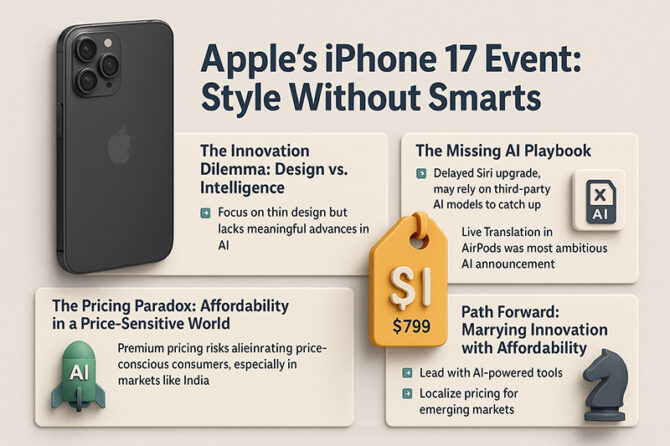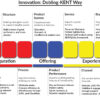
When Apple unveiled the iPhone 17 models at the highly anticipated September 2025 event, the market met it with skepticism. The stock dropped 1.7% to $234, illustrating investors’ worry. The keynote unveiled slender designs, new watches, and AirPods, but the inability to tell a compelling narrative on artificial intelligence (AI) was the miss itself.
Centering the keynote was the Apple-thinnest-ever iPhone Air, and it began at $999. Staging together the iPhone 17 Pro ($1,099), Pro Max ($1,199), and the budget iPhone 17 at $799 were the co-stars. Thinness stole headlines, but analysts were fast to highlight what was missing: groundbreaking intelligence advances.
The Innovation Dilemma: Design or Intelligence
Form obsession returned at Apple. The Air iPhone is the culmination of the company’s perennial thin and light product development goal. Investors and consumers demanded more than hardware upgrades in 2025, however. The keynote failed to deliver on a credible AI vision. Siri was nowhere to be seen, and features such as Visual Intelligence were rehashed from Worldwide Developers Conference (WWDC).
That contrasts with the Google Pixel 10, already installed with AI-enhanced programs for photography, productivity, and on-the-fly support. Apple’s restraining of its next-generation Siri until 2026, and rumour-mongering over the alternative possibility of relying on Google Gemini or another non-Apple AI platforms, emphasized its tardiness in the intelligence race.
As one analyst told The Economic Times: “Apple runs the risk of appearing as a design-first company at a time where intelligence-first is demanded.”
Hardware remains Apple’s forte—liquid-glass finishes, top-of-the-line cameras, and battery innovations. But the premium customer of the day queries: “Is my device more intelligent, not merely thin?”
The Pricing Paradox: Affordability in a Price-Sensitive World
Another source of tension is affordability. Apple’s pricing policy has never been for the masses but for the aspirational. In America, $999 for the Air phone can still be acceptable, but where prices are sensitive like India, the same amount signifies more than six months’ worth of median disposable income for an Indian middle-class professional.
Indian consumers are becoming more value-oriented. As per International Data Corporatoi (IDC) India, the ₹20,000–₹40,000-priced smartphone continues leading the growth of sales, and the OnePlus, Samsung, and Xiaomi models deliver AI-enabled offerings at nearly one-third the cost of an iPhone.
As Ratan Tata once said: “A product is not truly innovative unless it reaches the common man.”
That is where the risk of alienation falls for Apple. In focusing on premium prices without integrating game-altering AI, it risks losing share in the globe’s fastest-expanding smartphone market.
Gender and Social Action
History shows that continuous innovation, coupled with affordability, forges sustainable businesses.
• There is a Tesla lesson for the world. Elon Musk’s resolve to make electric vehicles cool and eventually within everybody’s grasp advanced the EV revolution. As he famously said: “Any product that’s too expensive can’t be called revolutionary—it can only be called luxury.”
• Reliance Jio’s 2016 entry into Indian telecom disrupted the sector by reducing the cost of data and taking the internet into the masses. What started as a pricing game transformed into a digital ecosystem across payments, retail, and streaming. Jio’s example illustrates the ability of making innovation available and reaching mass markets and transforming industries
Apple once served the same purpose. The iPod and the iPhone redefined their categories not merely through design, but through enabling capable tech for the masses. The company today is faced with the necessity of delivering iPhones capable of AI not merely as indulgences for the few.
The Missing AI Playbook
Artificial intelligence is the focal point of global tech duels. Through Microsoft’s Copilot, Google’s Gemini, and OpenAI’s ChatGPT add-ons, consumer products are increasingly defined by their smartness in catering to the user.
Apple’s unveiling of Live Translation within AirPods Pro 3 was the most ambitious AI unveiling. At $249, it provides real-time communication capabilities that can redefine worldwide travel and commerce. But the silence regarding Siri—the very assistant once at the core of Apple’s AI aspirations—said everything.
Warren Buffett, Apple’s largest individual shareholder through Berkshire Hathaway, once said: “In business, the rearview mirror is always clearer than the windshield.”
Apple must show it is not driving through a rearview mirror of hardware frenzy but through a windshield that demands AI leadership.
Why Timing Still Matters
Despite the criticism, it is too soon to write off Apple. Apple’s story is not one of first-to-market leadership but of going into markets where the tech was ready for scale. The iPod wasn’t the first MP3 player, the iPhone wasn’t the first smartphone, but when Apple went into markets, it transformed the industries.
As Steve Jobs famously said: “Innovation is saying no to a thousand things.”
Apple’s slow rollout might be one of careful timing—waiting until its AI platform is firm enough to deliver a seamless, privacy-obeying, and user-centric experience. If done right, its tardy AI play can still redefine the market.
Future Directions: Balancing Innovativeness and Affordability
To regain momentum, Apple must focus on two imperatives:
1. Frequent, Significant Innovation – Function, beyond form, is what Apple needs to innovate first. Intelligent tool utilization that streamlines healthcare, education, and productivity can be its next game-changer.
2. Affordability for Emerging Markets – By localization of pricing, subscription models, or affordable but intelligent devices, Apple can capture India, Africa, and Southeast Asia, the future growth drivers.
As N. R. Narayana Murthy, the Infosys founder, once said: “Innovative thinking earns respect, but accessibility creates trust.”
Apple’s mission is to win both.
Final thoughts
The iPhone 17 unveiling was disappointing for investors, but it is also a reminder: businesses can’t just bank on beauty in the age of AI. Success will be the domain of businesses that innovate consistently and make their wares available to the masses, not just the few. Apple’s thinnest smartphone yet seems svelte, but the hype it carries is enormous. The acid test comes later—once Apple decides to marry its mythical design DNA with an affordable and paradigm-shifting AI vision.
Dr. Prahlada N.B
MBBS (JJMMC), MS (PGIMER, Chandigarh).
MBA in Healthcare & Hospital Management (BITS, Pilani),
Postgraduate Certificate in Technology Leadership and Innovation (MIT, USA)
Executive Programme in Strategic Management (IIM, Lucknow)
Senior Management Programme in Healthcare Management (IIM, Kozhikode)
Advanced Certificate in AI for Digital Health and Imaging Program (IISc, Bengaluru).
Senior Professor and former Head,
Department of ENT-Head & Neck Surgery, Skull Base Surgery, Cochlear Implant Surgery.
Basaveshwara Medical College & Hospital, Chitradurga, Karnataka, India.
My Vision: I don’t want to be a genius. I want to be a person with a bundle of experience.
My Mission: Help others achieve their life’s objectives in my presence or absence!
My Values: Creating value for others.
Leave a reply
















Dear Dr. Prahlada N.B Sir,
Yesss….
Apple's iPhone 17 launch was more flash than substance, leaving investors skeptical. While the device's sleek design and upgraded features are undeniable, the lack of groundbreaking AI advancements was a major miss. It's time for Apple to shift focus from form to function and deliver intelligent tools that streamline life.
*Key Takeaways:*
– *Innovation Over Aesthetics*: Apple needs to prioritize AI-driven features that make a difference, like streamlining healthcare, education, and productivity.
– *Affordability Matters*: Localized pricing, subscription models, or affordable devices can help Apple tap into emerging markets like India.
– *Learning from Others*: Tesla and Reliance Jio show that innovation coupled with affordability can lead to sustainable growth.
Let's face it, Apple's current approach is like serving a fancy dish without flavor. To regain momentum, Apple must blend innovation with accessibility. As N. R. Narayana Murthy said, "Innovative thinking earns respect, but accessibility creates trust." Time for Apple to win both.
Reply